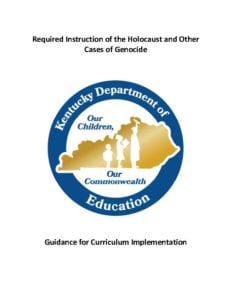
The cover of “Required Instruction of the Holocaust and Other Cases of Genocide: Guidance for Curriculum Implementation.”
The Kentucky Department of Education (KDE) has released a set of guidelines designed to help public schools across the state develop curricula to teach the Holocaust.
The 13-page document, titled Required Instruction of the Holocaust and Other Cases of Genocide: Guidance for Curriculum Implementation, gives academic standards, and sample evidence of learning at the seventh grade and high school levels to support those standards.
Release of the guidelines was the next step following last year’s passage of the Ann Klein and Fred Gross Holocaust Education Act, which mandates the teaching of the Holocaust and other acts of genocide to Kentucky’s public middle and high school students.
While the guidelines have met with some approval by educators, they have also generated questions about the selection of sample evidence.
Specifically, the seventh-grade standards make frequent references to anti-Semitism in the Middle Ages, connecting those lessons to the anti-Jewish laws of Nazi Germany, but the high school samples barely mention the Holocaust at all. They do, however, make frequent connections to the Rwandan genocide of 1994.
“It’s baffling to me that the evidence of learning veers away from the heart of our legislation, which was a Holocaust mandate,” said Fred Whittaker, who teaches Holocaust studies at St. Francis of Assisi School in the Highlands, and who lobbied for years for passage of the act. “I don’t understand why the examples don’t spotlight our original intent.”
The seventh grade standards reference anti-Jewish laws in Nazi Germany, comparing them to laws and rules from the Middle Ages, showing how “laws have been used to discriminate Jewish populations throughout history, mirroring similar laws passed by Nazi Germany.”
Those same standards and evidence samples also question how religion influenced state-building in the Middle Ages, which could result in discrimination against Jews. And they describe how some lands used Jewish bankers and traders to “stimulate trade and enhanced cultural interactions.”
But the high school evidence samples concentrate almost exclusively on Rwanda to show how governments, economic trends, environmental factors, migration patterns and population distribution could influence horrific results, such as the genocide, which murdered as many as 800,000 people. (Some sources set the death toll over 1 million.).
Asked about the lack of direct Holocaust references for the high school evidence samples, KDE spokeswoman Jessica Fletcher, in a written response, said the department “does not require specific curriculum or strategies to be used to teach the Kentucky Academic Standards (KAS) or to implement required legislation.”
She wrote, “It is important to note that the causes and implications of the Holocaust and other cases of genocide are vast and complex. The examples provided indicate a snapshot of Holocaust and genocide education and are not intended to fully capture the magnitude of these events.”
Overall, Whittaker called the guidelines “a wonderful starting place,” for Holocaust education” stating they are “opening the door to some great possibilities in terms of what teachers can expose students to and what they can create in their classrooms about the Shoah.”
The Holocaust Education Act specifically requires every public middle and high school in Kentucky to include instruction about the Holocaust and other cases of genocide “as defined by the United Nations Convention on the Prevention and Punishment of the Crime of Genocide, that a court of competent jurisdiction, whether a court in the United States or the International Court of Justice, has determined to have been committed by applying rigorous standards of due process.”
Dan Penner, who teaches Holocaust studies at Atherton High School, credited the KDE for providing numerous resources in the guidelines for developing a genocide studies curriculum.
But he, too, said the Holocaust “should be a major focus, if not the major focus” of the guidelines.
Whittaker said the law was originally intended not only to teach the Holocaust – and other acts of genocide – but to establish a connection between the students, the Jewish people and Judaism.
While the rationale behind the law does that, he said, more work must be done to assure that Kentucky schools go beyond the cold facts of the Shoah.
“If we are to honor the original intent of the legislation and the rationale … we have a lot of work to do in order to foster quality Holocaust education in classrooms,” Whittaker said.
One way to do that, he said, is to strengthen assessment of Holocaust curricula – something that is not called for by the law. “Because of that there may be less attention paid to Holocaust history than we would have hoped.”
Want to read it?
The KDE’s new guidelines for instruction of the Holocaust and other cases of genocide can be accessed online at https://bit.ly/2mfIo8f.



